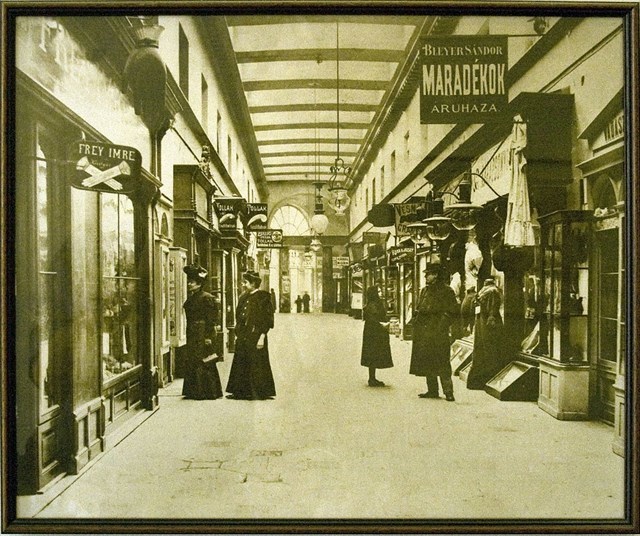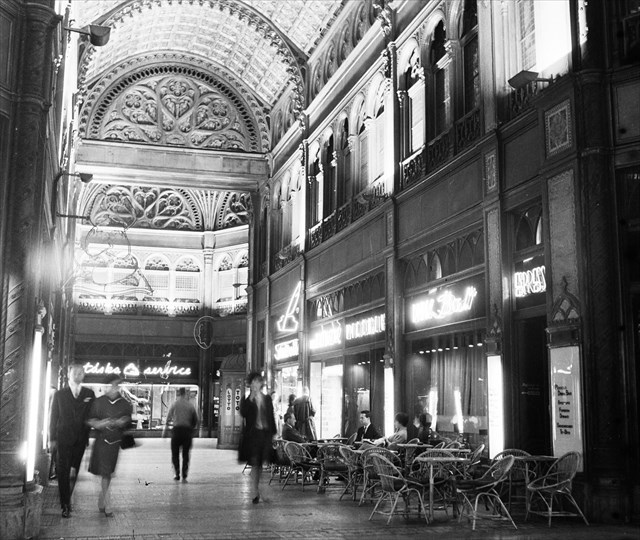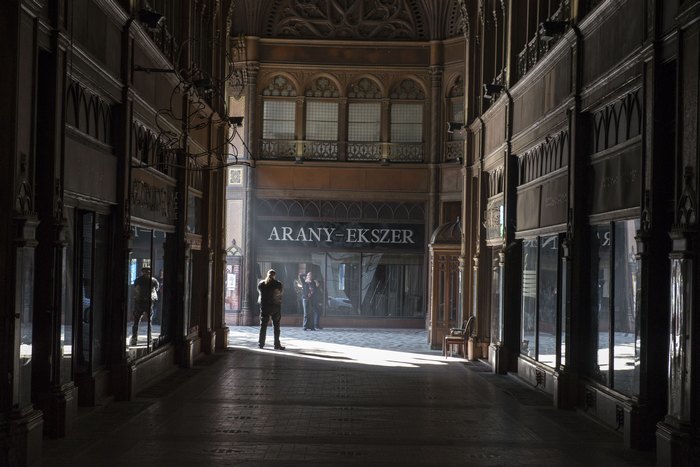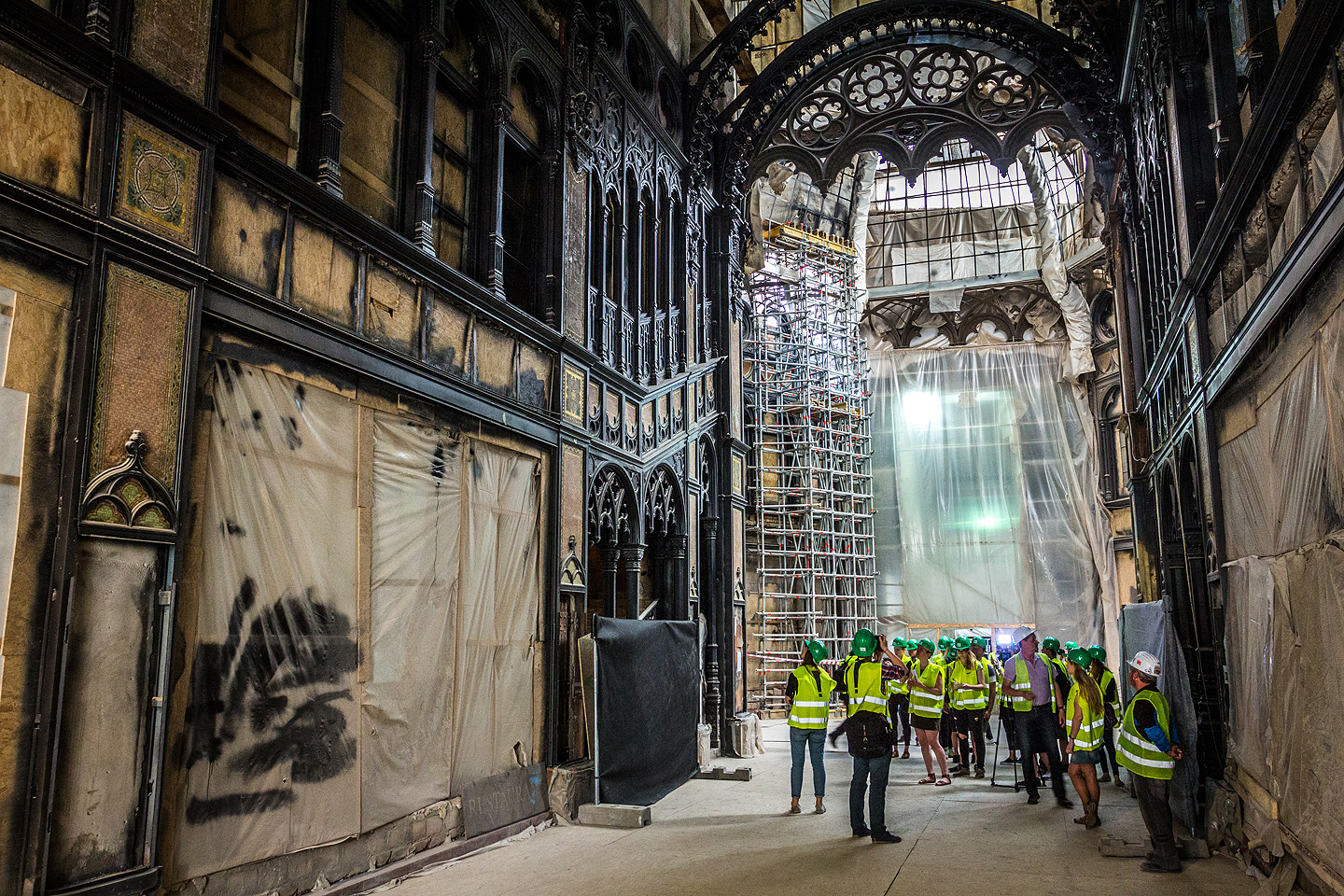
Párisi Udvar
Látogasd meg Budapest legszebb passzázsát, a frissen felújított Párisi Udvart az V. kerületi Ferenciek terén. Az ötcsillagos hotel lobbijaként a passzás az utcáról szabadon megközelíthető a 2019. ?? megnyitó után.

A ház helyén a XIX. században a város egyik első passzázsos, kétszintes üzletháza, a Pollack Mihály tervei alapján készült Brudern-bazár működött. Az áruházat az egykori Párizsi utca fölé emelték, és az 1799-ben épült párizsi Passage des panoramas mintájára lakították ki, így az épültet a "Párisi-ház" néven kezdték el emlegetni a pestiek. A Belvárosi Takarékpénztár Rt. 1906-ban vette meg Budapest legdrágább ingatlanát, és a bazár épületét elbontották, hogy új székházat, üzletházat, műtermeket és bérlakásokat építsenek.

A Párisi Udvar építkezése ezután kezdődhetett el, és 1909-1912 közötti években zajlott. Az építész a hamburgi származású Schmahl Henrik volt, aki egy egyedi, arab, mór és gót stílusjegyekkel bíró szecessziós épületet tervezett, melynek belső kialakításánál figyelembe vették a korábbi épület paszázsos jellegét is. A házon a kor legnevesebb mesterei dolgoztak, Zsolnay kerámiák, Róth Miksa üvegablakok, Villeroy & Boch mettlachi, Haas és Somogyi féle Luxfer üvegek, Jungfer Gyula műhelyében gyártott kovácsoltvas korlátok és kapuzat díszítik az épület számos pontját. A passzázs portálszerkezeteinek gyártója pedig az az angol cég volt, amelyik a londoni Harrods üzletház kirakatait is készítette.

Az épületnek mindkét utcára nyílik bejárata, mely bejáratokat hatszögű kiterjedésekkel osztott, dúsan tagozott, 2 szint magas, üvegboltozattal fedett passzázs köt össze. Az épület egyik különlegessége a passzázs luxfer prizmákból álló üvegtetője, amely felülről nem kap természetes fényt, nappal mégis ezt a látszatot kelti. Építészetileg pedig a belső architektúra üveg ornamentikájához illeszkedik. A rendkívül sokféle módon préselt kristályüvegek gyártása és összeállítása olyan bonyolult volt, hogy elkészülte két évbe telt.
Az elmúlt száz évben rengeteg belső átalakításon esett át az épület, melyet változó stílusú és minőségű falburkolatok, álmennyezetek, elfalazások jellemeztek. 1921-ben Vida Artúr tervei alapján emeletráépítést hajtottak végre rajta, 1941-ben pedig Cserba Dezső tervei alapján belső átalakításokat végeztek, 1959-ben az UVATERV építészeinek tervei alapján hozták létre. A szocializmus évei nagyobb pusztítást okoztak mint a II. világháború: az egykori pénztárterem eredeti pompáját felszámolták, a díszítéseket leverték, a freskókat pedig lemeszelték. 1960-tól a házat IBUSZ-palota néven emlegették, az ide költöztetett utazási iroda miatt.

A rendszerváltás után az épület véglegesen az V. kerület tulajdonába és üzemeltetésébe került. Forráshiány miatt az épület állaga az évek során folyamatosan romlott, a passzást folyamatosan hagyták el a bérlők és a Párizsi Udvar évekig üresen és sötéten állt. Az épületet 2012-ben vette meg a Párizs Property Kft. az ötödik kerülettől, e cég megbízásából végzi a felújítást a Mellow Mood Hotels, a Párisi Udvar leendő üzemeltetője. Zuhair Awad és Sameer Hamdan jordán üzletemberek üzemeltetik a szomszédos Klotild Palotában lévő Buddha Bart is, de portfóliójukban van még vagy 12 másik fővárosi szálloda is.

Az öt csillagos szálloda The Unbound Collection by Hyatt második európai tagjaként nyílik meg 2018. év végén.

Amennyiben szeretnéd logolni a virtuális ládát, teljesítsd az alábbi feladatokat.
1. Menj be a Párisi Udvar passzásába, állj az ólomüveg kupola alá és készíts róla fényképet, tölts fel a logodhoz.
2. Csodáld meg a passzázst és találd meg a számodra legkedvesebb építészeti részletet. Tölts fel róla olyan fényképet, ami bizonyítja, hogy ott jártál (szelfi, GPS, nickneved egy papíron stb.).
Virtual Reward - 2017/2018
Ez a virtuális láda része azoknak a korlátozott számban kihelyezhető virtuális ládáknak, melyeket 2017. augusztus 24. és 2018 augusztus 24. között rejtettek. Összesen 4.000 rejtő kapott lehetőséget virtuális láda rejtésére. Tudj meg többet a virtuális ládákról a Geocaching blogon.

Paris Court
Visit the most beautiful passage in Budapest, the newly renovated Paris Court in the V. District, Ferenciek square. After the renovation the passage serves also as the five-star hotel's lobby, from the street the passage is freely accessible after the ?? 2019 opening ceremony.

In the 18th century, one of the city's first two-storey shopping mallsstood on this place, the Brudern Bazaar based on Mihály Pollack's plans. The store was erected above the former Parisian street, and was designed after the Passage des panoramas in Paris, that was built in 1799. These two reasons are why the locals started to call the building as the "Páris House". In 1906, the Belvárosi Takarékpénztár Rt. bought the then most expensive real estate in Budapest, and the bazaar building was demolished to build new headquarters, shops, studios and rental apartments.

The construction of the Paris Court was then started and took place between 1909 and 1912. The architect was Henrik Schmahl from Hamburg, who designed a unique Art Nouveau building with Arabic, Moorish and Gothic style, with the interior design of the former building's passage character. The most famous masters of the time worked on the house, Zsolnay ceramics, Miksa Róth glass windows, Villeroy & Boch Mettlach type glasses, Haas and Somogyi Luxfer type glasses, wrought iron rails and gates made by Gyula Jungfer decorate many points of the building. The portal construction of the passage was manufactured by the English company, which also produced the London Harrods shop windows. The architect Henrik Schmahl died before the building was completed and maybe this played a role in the fact that the Historians still don't know the exact inauguration date of the building, they place it around 1912.

The building has two entrances to the streets, with entrances are connected by glass-ceiling covered passage. One of the peculiarities of the building are the Luxfer prisms of the passage glass roof, which does not get natural light from the top, but it gives this look in the daytime. And architecturally it fits in with the glass decoration of the interior architecture. The production and assembly of the crystal glasses in many ways was so complicated that it's completion took two years.
Over the past hundred years, the building has undergone a lot of internal transformation, characterized by varying styles and qualities of wall coverings, suspended ceilings, new wall structures. In 1921, a whole new floor was added and in 1941, according to plans by Dezső Cserba, internal alterations were made, and in 1959 redesign was made by the designs of the UVATERV architects. Years of socialism caused more destruction than the II. World War: the original treasury's original splendor was demolished, the decorations were crushed and the frescoes were painted over. From 1960, the house was known as IBUSZ Palace, due to the travel agency that moved here.

After the democratic transformation in 1989 the building was fully transferred to the V. Distircts ownership. Years of neglect followed, the tenants left the passage and it stood dark and haunting in it's beuaty for years. After a long period on the 'for sale' market, the building was finally acquired by Paris Property Ltd. from the fifth district in 2012. The renovation of the building is commissioned by Mellow Mood Hotels, the future operator of the Paris Court. Jordanian businessmen Zuhair Awad and Sameer Hamdan are the investors, they also own the neighboring Klotild Palace, but there are still 12 other Budapest hotels in their portfolio.

The 5 star hotel willbe the second European member of the Unbound Collection by Hyatt.

In order to succesfully log the cache, please complete the following tasks.
1. Go inside the Paris Court passage, stand under the dome of lead crystal, take a photo of it and upload it with your log.
2. Take a stroll in the passage and find your favorite artistical detail. Upload a photo of it with your log, that proves that you have been there (selfie, GPS, your nick on a paper etc.)
Virtual Reward - 2017/2018
This Virtual Cache is part of a limited release of Virtuals created between August 24, 2017 and August 24, 2018. Only 4,000 cache owners were given the opportunity to hide a Virtual Cache. Learn more about Virtual Rewards on the Geocaching Blog.